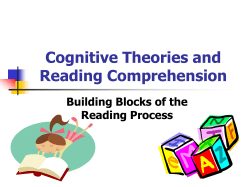
The simple view of reading
Teaching and Learning Resources p.1 tlr.nationalstrategies.dcsf.gov.uk The simple view of reading Letters and Sounds is based on a research-based theortetical model that combines word recognition skills and language comprehension skills to provide a ‘simple view of reading’. You can see how this is done and how it can be plotted on a basic quadrant to help you chart children’s progression. The ‘simple view of reading’ Systematic, high quality phonics teaching will prepare children for reading, helping them to recognise and decode words. However, if they are to become proficient readers and writers, they will also need to develop word recognition and language comprehension. The ‘simple view of reading’ recognises that both word recognition and language comprehension skills are essential for reading, but that neither is sufficient on its own. The development quadrant You can plot children’s development in simple stages on this quadrant to help identify their achievements, and where they might need extra support. In 2006, the Review recommended systematic, ‘high-quality phonics work’ as the prime means for teaching beginners to learn to read. The Review also emphasises the importance of fostering speaking and listening skills from birth onwards in the home environment, in Early Years settings and in schools, making full use of the rich opportunities for developing children’s language that all these provide. The Review affirms that children’s acquisition of speaking and listening skills, and phonic knowledge and skills, are greatly enhanced by a ‘multi-sensory’ approach. Examples of multi-sensory activities are given in the phases. Early Years practitioners will be fully familiar with this type of activity and the value it adds to other areas of learning and development in the Early Years Foundation Stage (EYFS). All of these considerations are embedded in the Primary Framework, in the EYFS and in Letters and Sounds. The purpose of high-quality phonic teaching is for children to secure the crucial skills of word decoding that lead to fluent and automatic reading, thus freeing them to concentrate on the meaning of the text. © Crown copyright 2011 Teaching and Learning Resources p.2 tlr.nationalstrategies.dcsf.gov.uk All but a very few children understand a great deal of spoken language long before they start learning to read. In order to comprehend text, however, children must first learn to recognise (decode) the words on the page. Once they can do this, they can use the same processes to make sense of written text as they use to understand spoken language. The ‘simple view’ shows that word recognition (decoding) and language comprehension are both necessary for proficient reading. However, the balance between the two changes as children acquire decoding skills, and progress from learning to read to reading to learn for information and pleasure. © Crown copyright 2011
© Copyright 2025





















